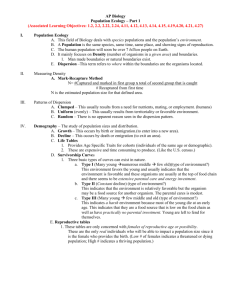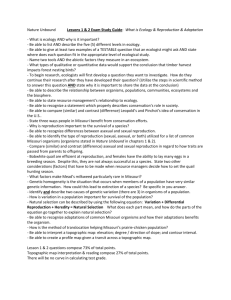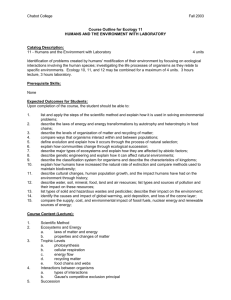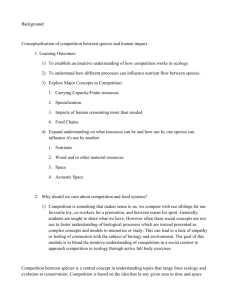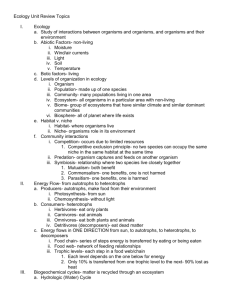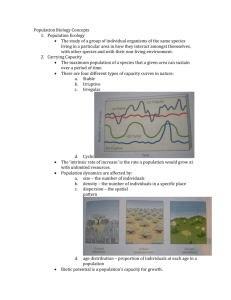6.2 Population Ecology Outline
advertisement
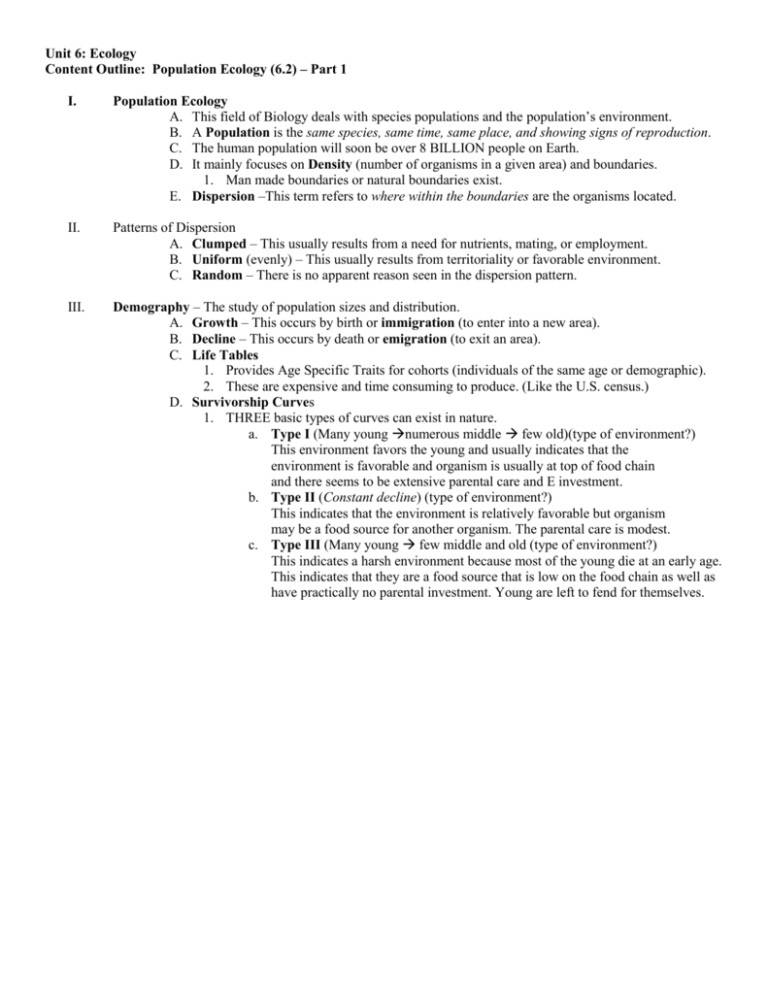
Unit 6: Ecology Content Outline: Population Ecology (6.2) – Part 1 I. Population Ecology A. This field of Biology deals with species populations and the population’s environment. B. A Population is the same species, same time, same place, and showing signs of reproduction. C. The human population will soon be over 8 BILLION people on Earth. D. It mainly focuses on Density (number of organisms in a given area) and boundaries. 1. Man made boundaries or natural boundaries exist. E. Dispersion –This term refers to where within the boundaries are the organisms located. II. Patterns of Dispersion A. Clumped – This usually results from a need for nutrients, mating, or employment. B. Uniform (evenly) – This usually results from territoriality or favorable environment. C. Random – There is no apparent reason seen in the dispersion pattern. III. Demography – The study of population sizes and distribution. A. Growth – This occurs by birth or immigration (to enter into a new area). B. Decline – This occurs by death or emigration (to exit an area). C. Life Tables 1. Provides Age Specific Traits for cohorts (individuals of the same age or demographic). 2. These are expensive and time consuming to produce. (Like the U.S. census.) D. Survivorship Curves 1. THREE basic types of curves can exist in nature. a. Type I (Many young numerous middle few old)(type of environment?) This environment favors the young and usually indicates that the environment is favorable and organism is usually at top of food chain and there seems to be extensive parental care and E investment. b. Type II (Constant decline) (type of environment?) This indicates that the environment is relatively favorable but organism may be a food source for another organism. The parental care is modest. c. Type III (Many young few middle and old (type of environment?) This indicates a harsh environment because most of the young die at an early age. This indicates that they are a food source that is low on the food chain as well as have practically no parental investment. Young are left to fend for themselves. Population Ecology (6.2) – Part 2 I. Population Growth Models A. Exponential Growth Models (Ideal Growth) 1. Involves r-selection species. (r- think rapid growth) 2. These species are also referred to as Density – independent species a. There population size is related to resources not number of organisms. 3. Produces a J curve graph. 4. Their environment has unlimited resources. (Good for ideal growth) 5. Occurs mainly in a new environments and pioneer species such as bacteria, lichens, and mosses. (They are the first organisms to colonize the new environment.) This is in areas that are just formed like Hawaii was millions of year ago. (Hawaii started as barren rock, until the pioneers arrived and began to make soil. The soil enabled plants to grow. The seeds of the plants arrived in the bird dropping of birds that stopped while migrating to feed on the mosses and lichens. Larger plant roots sped up soil formation to allow for larger plants.) 6. ZPG (Zero Population Growth) (r= 0) 7. Intrinsic growth = rmax (Population is growing as fast as possible/doubling. This is seen as the curve begins to make a straight up curve.) B. Logistic Growth Model (Realistic Growth) 1. Involves K-selection species. (K refers to a population that is hovering around the carrying capacity “which is represented by “K”) 2. These are referred to as Density – dependent species. a. These species numbers are about number because there are limited resources because the species is near the carrying capacity for that environment. 3. Produces an S curve graph. (“snakes” around the carrying capacity line) 4. Environment has limited resources; that is why organisms stay around the K. a. More organisms than K means damage WILL be done to the environment. b. More damage done to environment can cause K to drop even farther. This can be an example of a positive feedback loop. c. Wars, disease, and famine breakout in a population to bring numbers down below K. (Extinction is possible? depends on damage to environment and K.) 5. Lag time (This accounts for the overshoot.) – It takes time to begin to see the effects. (So the line goes above K and this is when death, war, disease, and famine accelerate.) Density Dependent are mostly living (biotic) things. (Competition, predators, prey, food, disease) Density Independent are mostly non-living (abiotic) things. (Sunlight, soil nutrients, wind, rain) Population Ecology – Part 3 I. Population Limiting Factors (All can limit a populations size… could even be more than one at a time.) A. Resources (This can be food, water, space…if it is a territorial species.) 1. Competition rises as resources become scares draining energy away from reproduction. B. Health conditions (Such as crowding and disease.) C. Predation by another species. D. Intrinsic Factors (Such as aggression, stress.)(Like personality issues with humans.) E. Carrying capacity for the given environment. II. Boom-Bust cycles of Growth (This describes a Predator/Prey relationship mainly.) A. Shows the Lag-time for other species to adjust to a change in a species population number. B. The two population “lines” are chasing each other because of their direct relationship. C. This relationship also promotes natural selection as it will be the strongest that survive and reproduce… so each species is causing the other to evolve… which is referred to as co-evolution. Human Population growth pattern A. The population explosion that is occurring has changed the dynamics of Earth tremendously. 1. Environmental degradation and over-consumption of resources is occurring. 2. Species loss (extinction) is occurring at a fast rate. 3. Overpopulation is being seen in India, China, and some other Island nation. B. Freedom/Control 1. China and India and United States China has imposed laws to get control of birth rates. (These can be found on the internet.) India has not yet imposed laws, but is seeing resource issues currently. The U.S. is not near the size in population as China or India ; but the United States uses most of the world’s resources; which is an issue for China and India and the rest of the world. The size of the U.S.’s Ecological Footprint is enormous. C. Human Growth History 1. The human species started as a Hunter gathers society. (Called nomads.)(Energy?) Their energy mainly went toward following the food so little was left for reproduction (They were basically too tired and health issues also drained energy.) 2. Agricultural Revolution and the plow With the invention of the plow, more food and not having to travel increased health and energy reserves. These could be put toward reproducing… so the population begins to climb. This also leads to the formation of towns and villages. 3. Industrial Revolution This help lead to cities because now everyone didn’t have to produce their own food, it could be grown in the countryside and trucked into the city for sale. Also this allowed for an increase in reserve E to put toward reproduction. Also health care improved for most people. 4. Technology Revolution and Medicine Better health causing people to live longer now and survival of babies increases. Women, in general, are having more children because families are becoming more affluent. Technology, while mostly good for society, makes most people less active and puts even more E toward reproduction and obesity. Ecological Footprint A. A measurement that takes into account the amount of water and land needed to produce all used products (resources) and dispose of all generated waste as a result of that same product (trash in landfills). III. IV.

